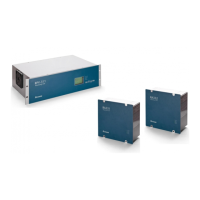4 TRAVELING WAVE FAULT RECORDS
Faults in a transmission line cause transients traveling along the line as waves composed of by a
frequencies ranging of a few kilohertz to several megahertz.
These traveling waves have a wave front with a very fast rise time and a down time which is relatively slow.
The waves move at speeds near that of light, away of the fault point toward the end points of the line.
The waves are not limited to the transmission line where the fault occurred, spreading through the adjacent
electrical system with decreasing amplitude, the result of the combined effects of the impedance of the line
and successive reflections.
Fault location by traveling waves is based on accurate determination of the moment that the wave fronts
pass the two terminals of the line. The traveling wave recorder can be triggered by a Boolean equation.
4.1 PRE-CONDITIONS
The traveling wave fault location requires that a second equipment with the same functionality is installed at
the other end of the monitored power line.
Both units have to be synchronized by an IRIG-B signal with less than 100 ns jitter.
Specific traveling wave fault location software must be installed in the user´s computer. This software, using
the traveling wave records of both terminal lines and the power line parameters, executes the fault location
algorithm and shows the fault location estimation. For details about the Traveling Waves Fault Locator
software, please refer to Chapter 12 and Chapter 13.
4.2 SAMPLING RATE AND ACQUISITION
The acquisition module RA333 has 3 independent channels (one circuit A, B, C), with an 8 bit A/D converter.
The sampling frequency acquisition is 5 MHz, synchronized by a PPS signal, which means one acquisition
each 200 ns.
The acquisition module conditions the line voltage signal. With an efficient band-pass filter the passing
frequency is limited between 1 kHz and 1 MHz.
The module constantly acquires signals and storing the measured values locally in a 64 Mbytes RAM
(approximately 4 seconds). The data is written into a circular buffer where the oldest data will be overwritten
by the latest until a threshold violation occurs.
On detecting violation of the threshold, the memory writing is interrupted. The memorized data is sent to the
processing module at this moment. The complete transfer of data takes about 2 minutes, and in this time the
BUSY indicators are lit.
While data is being transferred to the processing module (2 minutes), new TW records will not be registered;.
During this time, the other acquisition and processing modules continue functioning normally.
4.3 RECORDING TIMES

